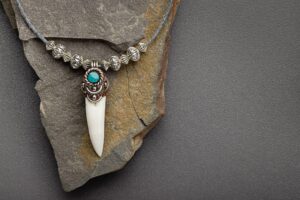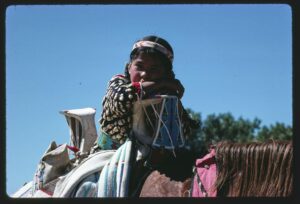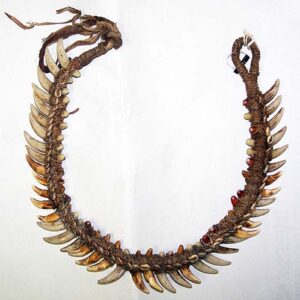Did you know that chewing and eating are not the only uses for teeth? Humans and
other animals use teeth for this purpose, but tribes around the world have always used
animal teeth for many different things. Let's explore some of these uses throughout
history.
North American Tribes and Their Use of Animal Teeth

Native American tribes have always used all parts of an animal to craft household
utensils, weapons, clothing accessories, and jewelry, just to mention a few. People from
these cultures used teeth to craft jewelry accents, such as beads and pendants for
necklaces. Even now, some of the North American tribes accept animals that wildlife
personnel acquire from deaths due to vehicular accidents and poachers.
The Significance of Animal Teeth to Native American Tribes
Because Native Americans believe in honoring the life of an animal, they believe no part
of one that has been killed should be wasted and that using all of an animal’s parts
relates to renewal and continuation of life. Some tribes see the animal's body parts as a
means to ask the animal's spirit to share its wisdom with the one who took its life.
With this concept in mind, remember that teeth are not simply seen as decorative or
valuable. Some native tribes believed that the spirit retained in the animal's teeth would
share wisdom for finding food when hunting and patience during any conflict within the
family. Some tribes referred to it as "the wisdom of the teeth!"
Using Animal Teeth for Decoration

Crow girl relaxing on a horse after the morning parade at the Crow Fair. Crow Agency, Montana, August 17, 1979. Photo by
Michael Crummett. Montana Folklife Survey Collection
Elk Teeth
An elk's two incisor teeth do not decay or break down. The Northern Plains natives used
these teeth for decoration and as a type of currency for trade.
The photo above clearly shows the use of elk's teeth all over this little girl's dress from
the Crow tribe of Montana. Clothing with these teeth as decoration has usually only
been worn on ceremonial occasions.
Think of how long it may have taken for a hunter to save enough teeth to decorate this
dress! Sometimes, the teeth were added to the garment over time. They may have
collected them slowly and added them at a particular time in the girl's life.
Each tooth has a single hole drilled through it so that it may be sewn onto the dress.
These types of clothing display the status of the family – their hunting ability and ability
to trade with others, and stand out as a symbol of their identity as Plains women.
The teeth of an elk are still highly valued and represent wealth. They are used during
festivities to adorn traditional regalia (dress representing a particular culture or belief)
and are often used in jewelry.
Coyote Teeth
Many tribes used coyote teeth to create art or to decorate clothing for ceremonies and
festivals. Early teeth had holes drilled into them to allow animal sinew or string to be
passed through them to make jewelry or decorations for clothing. Later, some tribes
added silversmithing to their art and capped the teeth with silver, no longer needing to
make holes in the teeth.
Using Animal Teeth for Tools
Some tribes used the razor-sharp teeth of red-bellied piranha to make saws, hunting
tools, and implements to use in their cooking areas.
Other tribes made knives and other sharp tools from beavers' teeth to cut and saw
things since their teeth are naturally sharp and extremely durable. Scientists have found
the incisors of beavers and arctic foxes crafted into tools in archaeological digs. Early
tribes used them for manual labor and food preparation.
How Teeth Were Are Used in Other Cultures

This dog tooth necklace is in the Timothy S.Y. Lam Museum of Anthropology, Winston-Salem, NC.
Until the 20th century, some parts of the world used animal teeth as money! In the
Solomon Islands, people used dolphin and bat teeth as payment.
Wild pig teeth were used as currency in Papua New Guinea until the early 20th century.
In pre-colonial days, people also used dog teeth as exchange payments, and the teeth
had to be of a specific size and quality for trading and jewelry crafting.
In the Fiji Islands, sperm whale teeth were the most valuable form of currency. Because
they are rare, these whale teeth are still used as Fiji bridal gifts and are sacred objects.
Size determines the value of each tooth, with the larger ones being more prized. Before
1900, sperm whale teeth could purchase property and other goods, and, even the
"elimination" of a rival chieftain!
Animal Teeth in the Mesolithic Period
In several crypts and graves in south Sweden, archaeologists found animal teeth that
made up intricately designed jewelry items and clothing. It seems that if the apparel was
decorated with more than one type of animal's teeth, the more significant that person
was in society. There were beads made of the teeth of red deer, wild boar, elk, bears,
and a few other animals that decorated the clothes, such as belts, buttons, and, in rare
instances, hair or headpieces.
Interestingly, the scientists also determined by the teeth that were used on the clothing
that some of the people were not native to the area where they were buried.
Mentions of Teeth in Ancient Native Folklore
We have looked at some of the fascinating beliefs about teeth throughout time before,
and many tribes of North and South America have passed down their own dental
traditions. Here are just a few examples:
Chippewa - This tribe paints baby teeth with charcoal, throws them to the west, and
asks the child's grandmother to help their adult teeth grow strong.
Teton - Children bury their teeth in the entryway of their homes, and anyone walking
over them is thought to help them grow a new tooth.
Dene Yellowknives Tribe - Children give their lost teeth to their mothers or
grandmothers to put into trees. The family then dances around the tree to encourage
the adult teeth to grow as straight as a tree.
Tribes of Chile and Costa Rica - The first baby tooth lost is gold-plated or coated with
some other precious metal and used as a charm or an earring.
Navajo – The children bury their lost teeth on the east side of sagebrush or rabbitbrush,
or near a pinyon tree on the southeast side of the property, away from their home,
hoping it will help their teeth grow strong.
Key Animal Teeth Takeaways
Native Americans and tribes worldwide have used animal teeth for various purposes in
their daily lives and ceremonies. Whether for decoration, tool formation, currency, or
trading, animal teeth have been very significant to cultures around the world, throughout
history.
Nowadays, teeth don’t have the same uses, but still impact our lives! We still need to
keep our teeth healthy, and people care about having a beautiful smile. At Jungle Roots,
we are here to help you on your journey to your best smile! We love helping people
enjoy beautiful, healthy teeth. Contact us today for an appointment!
